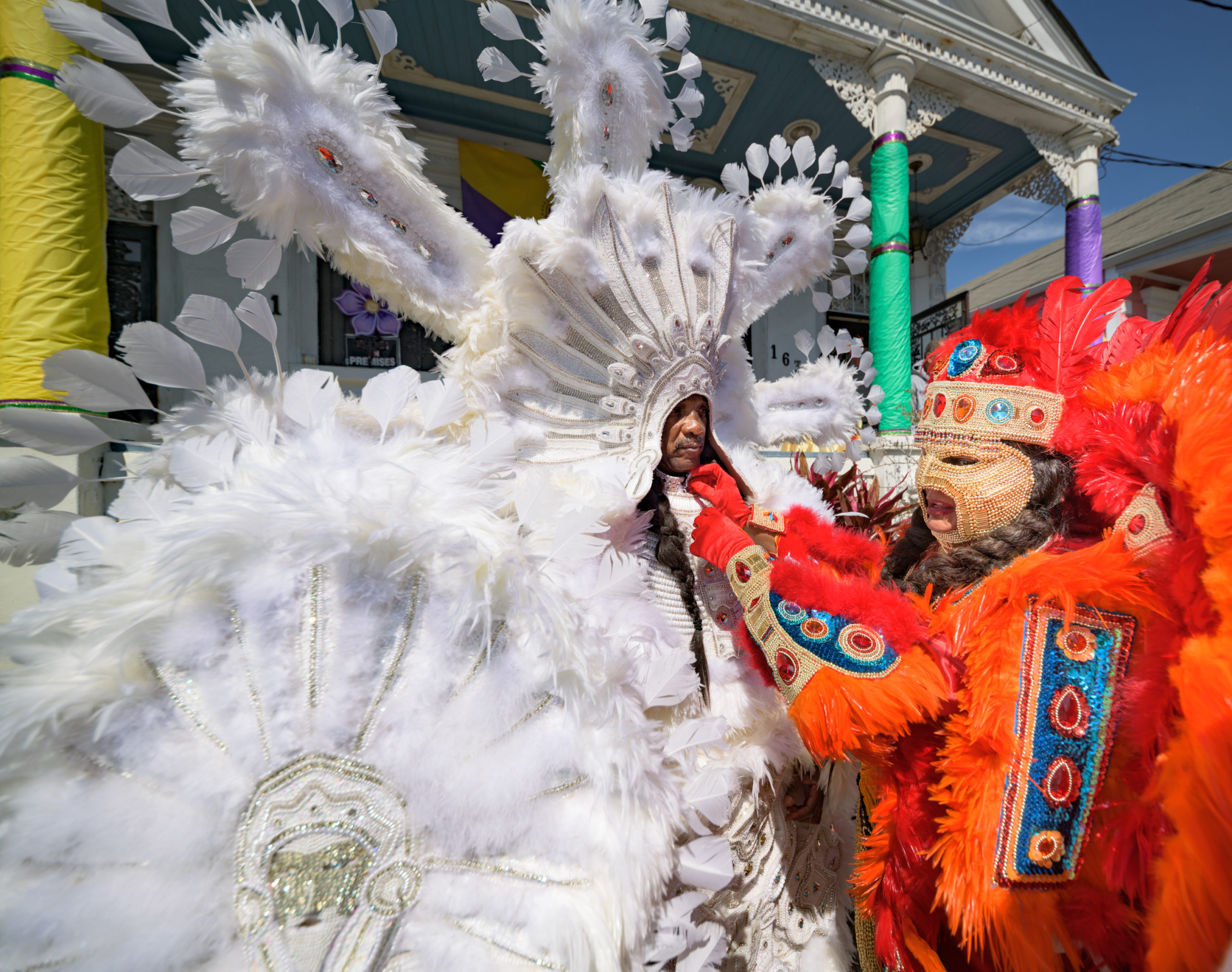Darryl Montana, the Big Chief of the Yellow Pocahontas Black Masking Indians, has been sewing his suit for two years, his needle poking again and again through poster board and cloth and leaving behind tiny colorful beads, sequins, pearls, and thread. Later he adds bright giant ostrich feathers and smaller, softer marabou or the down feathers from turkeys.
In the bright light of Mardi Gras mornings, the dancing and colorful beads and feathers from Montana’s suits are so vivid and saturated they leave an afterimage on the retinas. Accompanied by the shaking and thumping tambourine, and the singing and yelling of the traditional chants, the boisterous scene leaves a memory etched on the mind long after.
As he came out in a blinding brilliant pearl and white beaded suit on Mardi Gras, March 1, 2022, a man in the crowd yelled out “Big Ole Chief! Pretty in the front and pretty in the back!”
Montana says, “I’m chief of my neighborhood, but I feel like I’m chief of the city. You not gonna see anybody else nowhere close to looking like what I look like, period.”
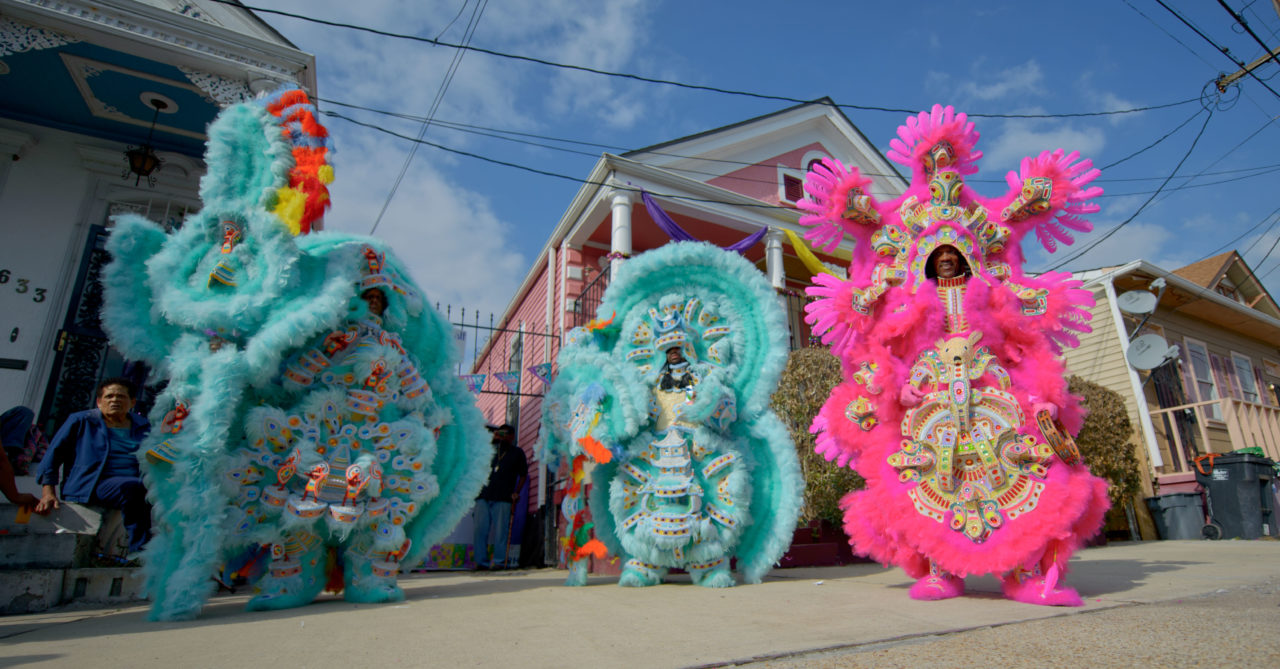
Generations of Culture
The traditional starting chant for the spirited culture is called “My Indian Red” dating from the early 1900s and begins with a French-Creole phrase “Madi cu defio, en dans dey, end dans day!” Like many words of the Creole language, the exact meaning of the phrase has been lost to history, but it is believed to mean “I am going into the wilderness,” according to Creole scholar Sybil Rein.
The song continues in English and details the procession of the tribe through the neighborhood.
“We are the Indians, Indians, Indians of the nation
The wild, wild creation
Oh, We won’t bow down (We won’t bow down)
Down on the ground, (On that dirty ground)
Here comes the Big Chief,
the Big Chief the Yellow Pocahontas . . .
Here comes the Spy Boy, the Flag Boy,
but watch that crazy Wild Man,
the wildest in the lowland
and you’ll love our Queen,
Queen of New Orleans.
Oh, how we love to hear you call us Indian red.”
For his crown this year, Montana is adding glass gemstones and three-dimensional sculptural and abstract elements. The elements are made with interlacing strips creating a latticework, a skill passed down to Darryl by his father, the Chief of Chiefs Allison “Tootie” Montana (1922-2005). Tootie Montana was a skilled lather and made latticework for buildings including the façade of Le Pavillon Hotel on Poydras St. Darryl Montana’s great-great-uncle, Becate Batiste or Baptiste Eugene, was a 7th Ward plasterer and Big Chief of the Creole Wild West Indians, which is the first known gang of masking Indians from the 1880-90s. Darryl Montana is the fourth generation and his grandchildren represent the sixth generation of this unique New Orleans Black masking Carnival culture.
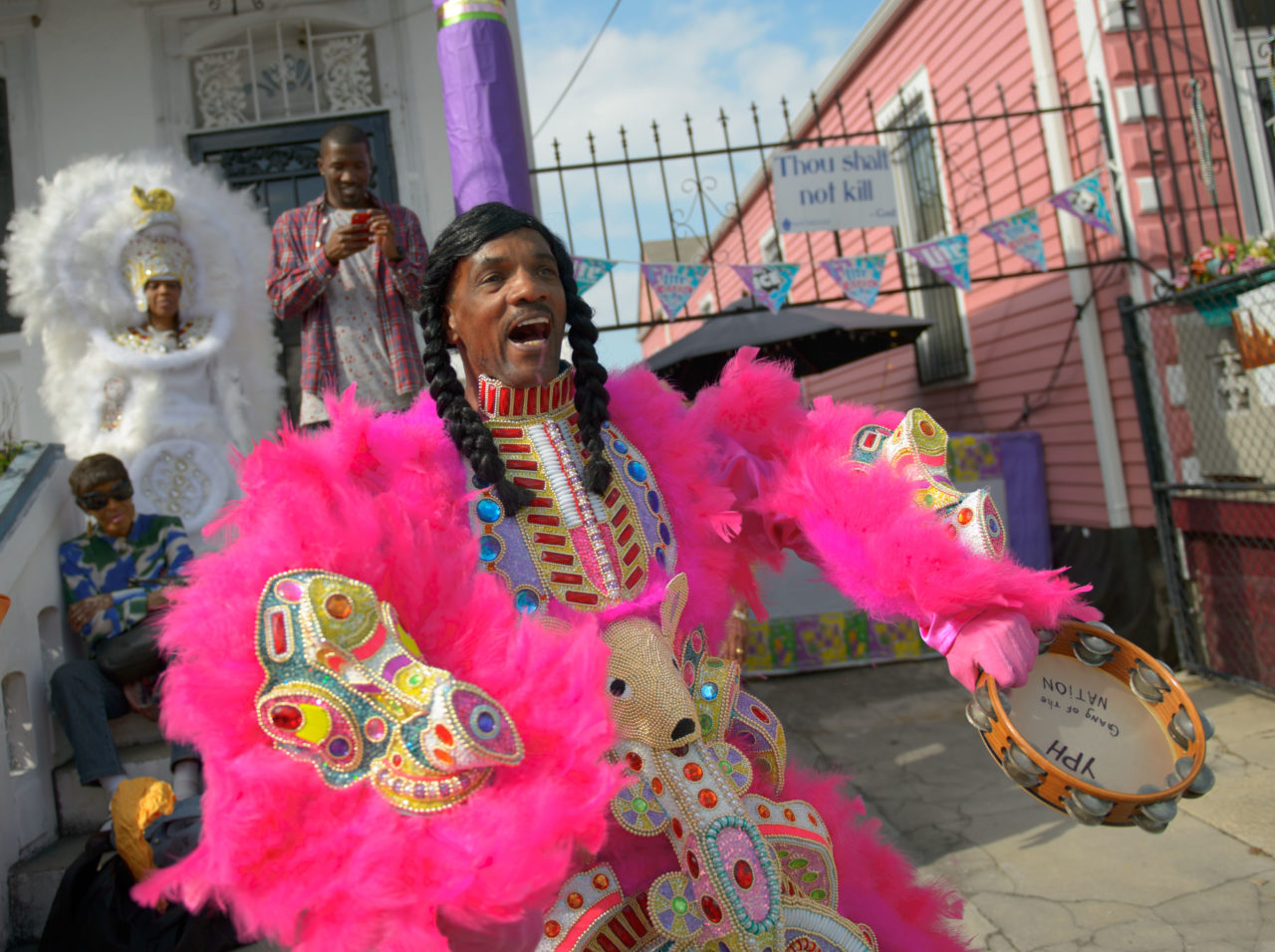
Coming Back from Retirement
In 2017, Montana retired as Big Chief. He had been hurting physically and emotionally by both carrying and building suits for almost fifty years. Every year, he would begin after his birthday in April and sew the following ten months over thousands of hours up to Fat Tuesday.
“I say that I wouldn’t wish making a suit on my worst enemy because it takes so much. It takes your life,” he said.
The intricate works of art require thousands of dollars of beads and feathers and can weigh 75-100 pounds, as much as a sofa. The prolonged hours of sitting and sewing didn’t help either, “it was starting to be torture to sit. I guess I needed to heal ‘cause at the end, my back couldn’t take it no more.”
Montana also went through a divorce. “Life hasn’t been a crystal palace since I last masked,” he said while sewing in the home of his new queen, Dianne “Gumbo Marie” Honoré, 57, who he met in 2019.
“His love and understanding of our culture really attracted me to him. We lived while growing up literally blocks apart,” said Honoré. A former nurse, she began walking with Montana every morning with her dog in Tremé, the oldest Black neighborhood in the United States. The three years and many miles of walking with Honoré, helped strengthen and nurse his back to better health. Honoré later motivated him to take up sewing again. He sewed a patch for her baby doll outfit and, eventually, he began mentoring her while she designed and sewed a white Indian queen suit that debuted in 2021.
Inspired by Honoré’s creativity, Montana’s flame has been rekindled and will help bring him back from retirement five years later.
“I have one more suit in me. I got a little flicker still left, the torch, the flame is not all the way out. And this suit here, I’m using materials that I wouldn’t normally use. It’s like an experiment, but I know it’s gonna work. That’s the excitement of it, to challenge yourself,” Montana said. “[Part of the] challenge of it is creating your own. When you come from under somebody like my daddy, where he basically wrote the script, you got to get outside that and create your own identity.”
Darryl Montana’s own work has been recognized nationally and globally with exhibits in Paris, France; England and Italy. He has been an artist in residence in 18th Street Arts Center in Southern California in 2006 and received grants including the Joan Mitchell Foundation. One suit is on display at Crystal Bridges Museum of American Art in Bentonville, Arkansas, created by billionaire Alice Walton, a co-owner of Wal-Mart.
Montana thought about joining Honoré in 2021 but decided against suiting up with a large gang because of the COVID-19 pandemic. He’s been sewing a new suit for Mardi Gras 2022 for nearly two years.
“With COVID, it’s like throughout the country, we’ve been in a cage, in a bubble. For me to come out this year versus all the other years is like freedom. You can’t cage a bird,” Montana said.
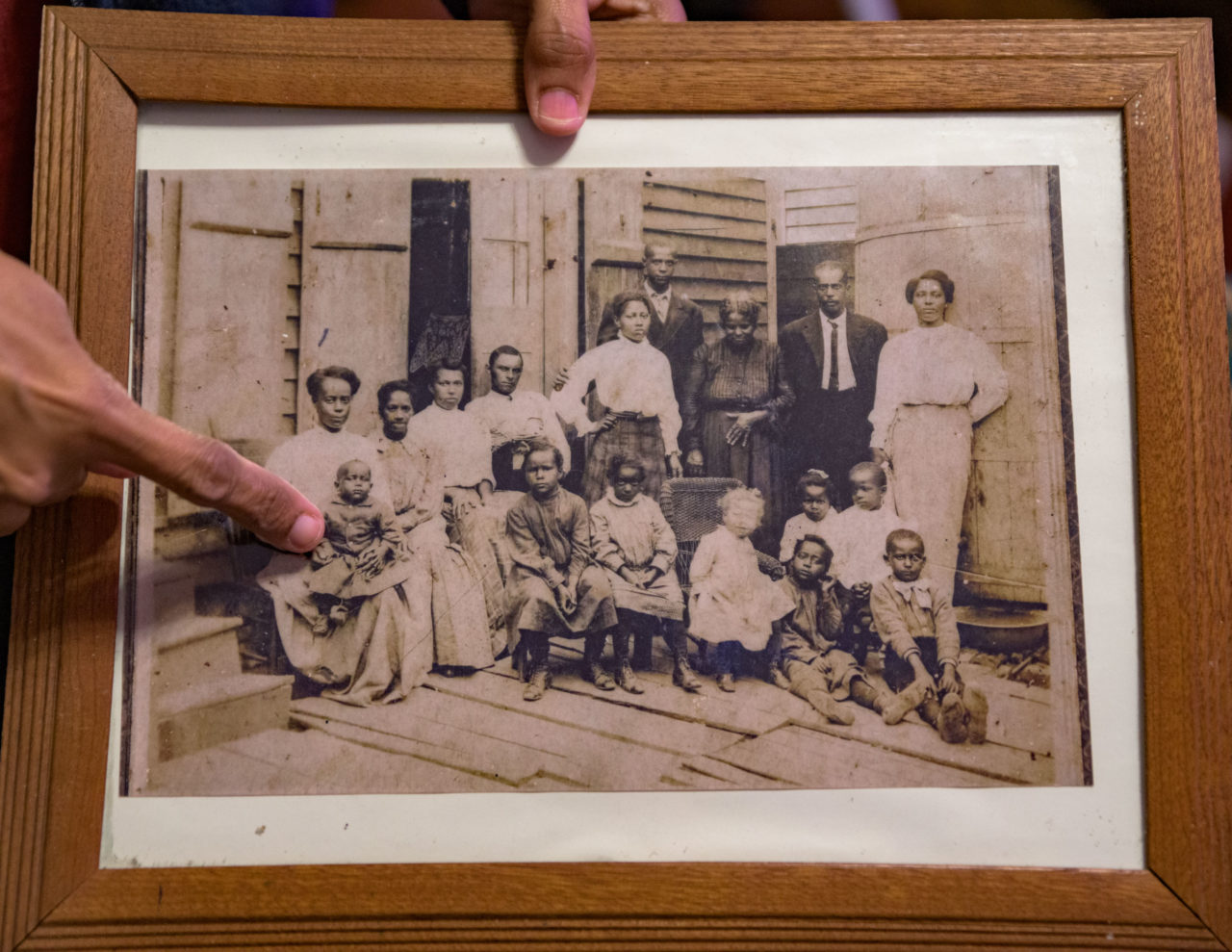
Three Centuries of Drums and Feathers
In Black Masking Indian traditions and stories gangs or tribes are said to be descendants of Maroons, enslaved people who escaped to freedom in the swamps, bayous, and lakes around the city and were aided by Native Americans.
Starting in the colonial period in the 1700s enslaved people in New Orleans were given weekends off and would often gather with Native Americans and Maroons in Congo Square, part of present-day Louis Armstrong Park inside Tremé. In 2010, a statue was erected by Congo Square of Big Chief Tootie Montana wearing an elaborate three-dimensional suit evocative of the Downtown Indians style. Darryl Montana and other Black Masking Indians now celebrate the start of Carnival on January 6, singing chants and rattling tambourines by the statue. For nearly three centuries feathers and drum beats from the different cultures have inhabited the same space in the neighborhood.
The Big Chief Tootie statue was erected near the end of the second and final term of Mayor C. Ray Nagin, but the mayor and preceding administrations were not always as welcoming of the Black Masking Indian tradition. During Nagin’s first term, Big Chief Tootie Montana, 82, spoke before the New Orleans City Council on June 27, 2005, about confrontations with police over many decades. Tootie recounted when Darryl and his brother went out in their first Indian suits in 1965 on Mardi Gras and joined other revelers in the French Quarter. Darryl recalled “I remember I was nine and my brother, Charles, was thirteen. My brother went to do a little Indian move and a white police officer took out his billy club, and at that time they had [lead-linings] in them things, and he swung at my brother’s head.” The officer missed, but after that incident Tootie stopped taking his boys into the Quarter during Mardi Gras. “At that time racism was, it was happening,” Darryl recalls.
Mardi Gras Krewes were not desegregated until 1992 when the city council passed an ordinance making it illegal for a segregated krewe to participate in Mardi Gras. The all-white Mystic Krewe of Comus, which held the first organized New Orleans Mardi Gras parade in 1857, refused to integrate and held its last parade in 1991. Mardi Gras, especially during the Jim Crow segregation era, has historically been divided along racial lines. Montana recalls attending a parade when he was around age seven in the 1960s, “rather than let me catch the beads, white folks would step on them and break ’em or step on my hand.” These aggressive actions failed to recognize Montana’s humanity and instead treated him as something that needed to be punished and policed. “A lot of us had those types of experiences as young Black men and little Black boys, and that made me gravitate more to the [Black Masking Indians].”
“In our neighborhood, it was always Carnival Indians or Black Indians. ‘Mardi Gras Indians’ folks put that title on us, but we didn’t call ourselves that. You’re not gonna say who I am. All of us that’s doing it are Black, you know? We telling you who we are, and no, we are not ‘Mardi Gras,’ we are Black. I call myself a Black Masking Indian,” Montana said.
The Black Masking Indian ritual is essentially a mock war game with no defined route through the backstreets of majority Black working-class neighborhoods. While second line or Mardi Gras parades have defined routes, the Indians’ routes are always secretive and stay in the backstreets. The secret routes are necessary to avoid being surrounded by other tribes. In the past, rival tribes or gangs might occasionally clash or fight in the street and a “humbug” could occur, especially if a gang demanded another gang to bow down.
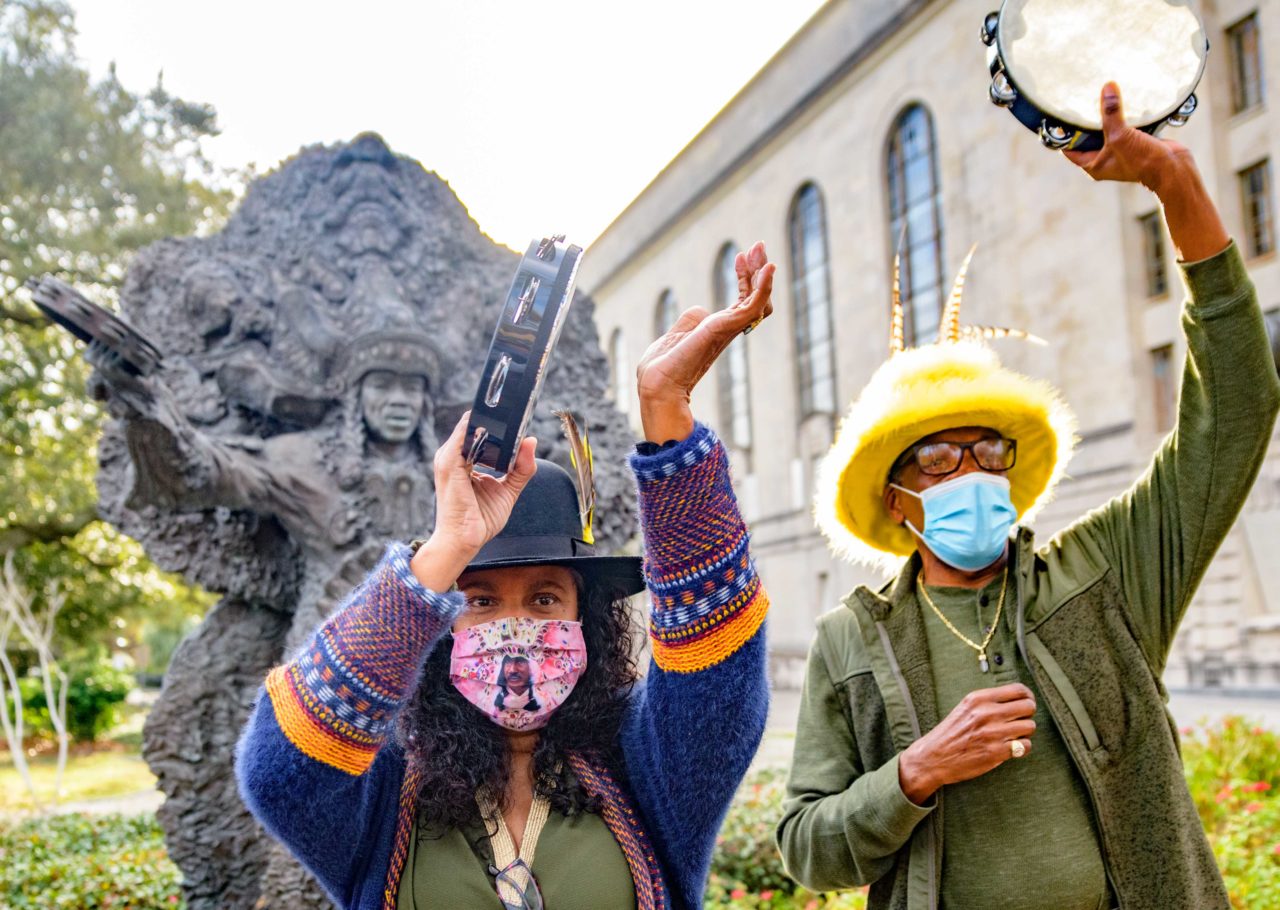
The Legacy of Big Chief Tootie
Though clashes occurred in the early days of the tradition, Tootie Montana is credited with changing the culture of Black Masking Indians from the settling of scores between tribes to a day of pageantry and celebration of the culture. “It went from physically fighting to where we fight now with the needle and thread, and to see who can be the prettiest,” Darryl Montana said.
Darryl Montana was with his father Tootie Montana in 2005 as Tootie addressed the city council about the many years of police harassment including a more recent incident on March 19, 2005. March 19 is St. Joseph’s Night, and second only to Mardi Gras in importance to the Black Masking Indian culture. Police dispersed the traditional gathering that evening with some officers being physically abusive. Tootie addressed the council, “I want this to stop.” They were to be his last words as he suffered a fatal heart attack and fell. According to journalist Michael Pearlstein, “after Tootie Montana fell. . . the chiefs and spy boys and flag boys and queens of the assembled tribes launched into a somber rendition of ‘Indian Red.’”
Darryl Montana looks a lot like his father. “I have all of his mannerisms; my hands look like his hands.” Standing next to his father as he passed in City Hall, “I kind of felt like his spirit left his body and came into mine.” Tootie’s funeral was held at St. Augustine Church in Tremé, the oldest Black Catholic parish in the United States.
In May 2010, shortly after Big Chief Tootie Montana’s statue was erected and Mayor Nagin had departed, the new elected Mayor Mitch Landrieu, invited the United States Department of Justice (DOJ) to investigate a pattern of civil rights violations and other misconduct by the New Orleans Police Department (NOPD). In 2012, the NOPD entered into a federal consent decree with the DOJ and instituted departmentwide reforms.
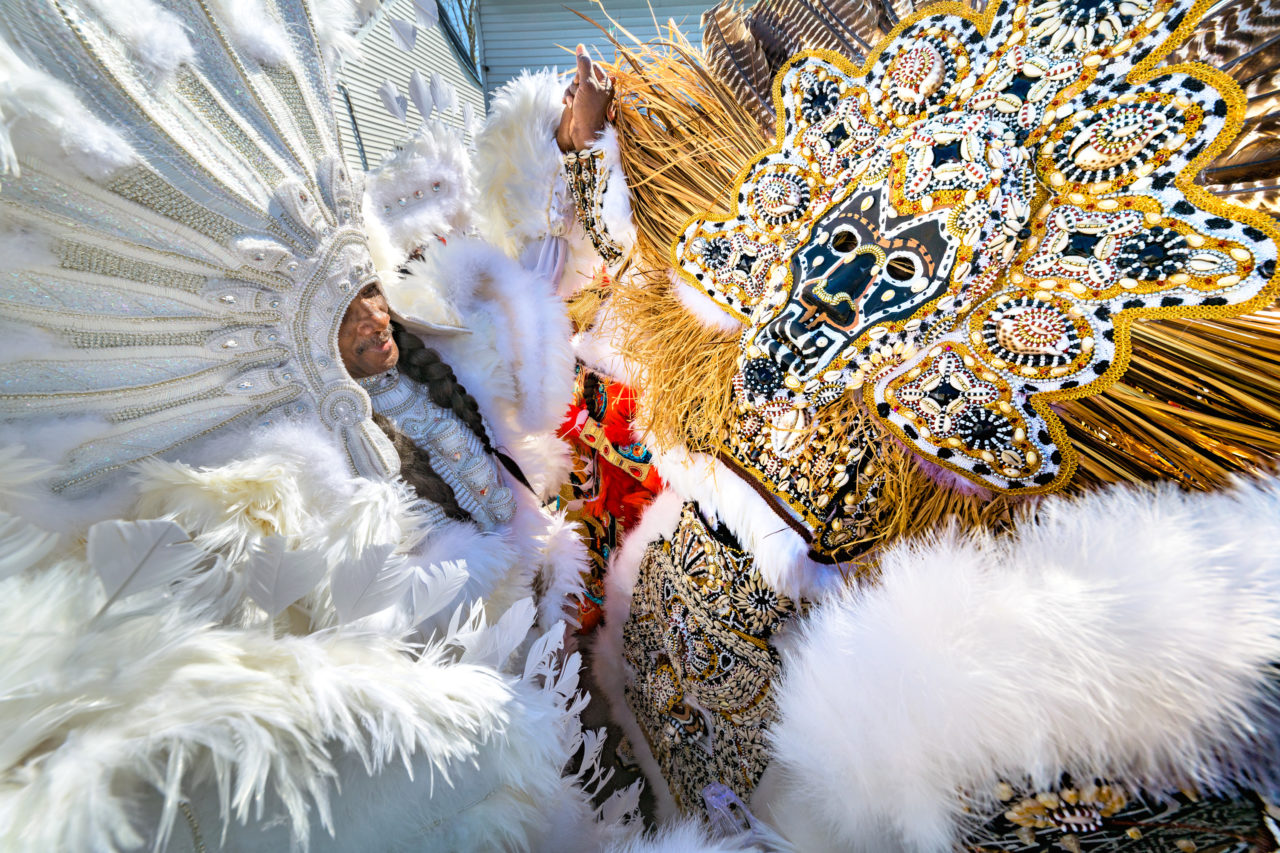
Putting on the mask
Putting on the mask is a lot of work but the end result is often spiritual and transcendent.
“When you’re working on a suit you are working days and days and you’ve been up all night, your energy is gone, but when you put the suit on, all of that stuff leaves and you get a boost of energy and adrenaline,” Darryl Montana said.
Normally, when he passes people on the street, he stops to acknowledge them, bumps fists and has a conversation. But when he is playing Indian with the same people they will say, “I was right there on the side of you. And I’ll say, “really?” But you don’t remember. You forget all those faces and your focus be on that Indian in front of you. You be so focused, it’s like you are a whole other person. You go through a metamorphosis; you play the suit. “
Honoré said, “It’s an intense experience. It’s like a possession, we become something else that feels stronger and bigger. And it’s not all about a really pretty suit. You have to partake in the ritual and dance and meet up with other people. You have to know what to say and how to move and what the movements mean.”
Honoré, who has dressed as a baby doll, a voodoo priestess, an Amazon warrior, and historical interpreter makes a clear distinction on the significance of masking Indian. “Out of all the Mardi Gras traditions, it’s the only one that totally embraces your ancestral history and spirituality. It started way back in Africa and hundreds of years ago here with the Native Americans. It’s timeless wearing feathers and doing the rituals.” Honoré compares the public spectacle of masking to walking into a village and seeing Voodoo or Catholic rituals or initiations.
Many enslaved people originate from Senegal, Gambia, and Mali countries of West Africa, where many ethnic groups have masking traditions including the Kankurang masking ritual among the Mandinka or Mandingo people. Big Chief Victor Harris, who was a spy boy in the Yellow Pocahontas under Tootie Montana, later formed his own tribe called the Spirit of Fi Yi Yi and Mandingo Warriors. The wild man or moss man in Black Masking Indian tribes use grass skirts that often resemble African masking traditions and initiations.
Honoré said “[Black Masking Indians] mimic a lot of what the Africans and Native Americans did and you get the Creole mixed in with that.” Creole Wild West Big Chief Becate Batiste was part Choctaw, a Native American tribe; French; African-American; and Catholic.
Creole is a term with different meanings in different historical periods. Originally meaning the descendants of Europeans born in the colonies, the term has evolved to define different ethnic groups created by the mixing or creolization of French, Spanish, Native Americans, and Africans in the former colonies like Louisiana. Cajuns or Acadians for example are a subset of Louisiana Creoles, but in present usage in New Orleans, Creoles refer to Black or multiracial people, while Cajuns refer mostly to white people. Creole also includes the French-Creole language that Darryl Montana would hear in conversations between his father, Tootie; grandfather, Alfred Montana; and grandmother, Alice Montana.
Though she lived nearby in the same neighborhoods and saw Black Masking Indians in the streets, Honoré did not know she was linked to the masking culture until later in life, when she started to make her first suit with Montana. Honoré’s cousin, Eugene Honoré, 1892-1931, is credited as the original songwriter of the “Indian Red” chant, he was also part Choctaw and Big Chief of the Wildcats in 1919. The late in life recognition of a deep-rooted connection to the culture caused a profound moment of reflection for Dianne Honoré and she said, “I cried.”
The song of the chant was first recorded by the legendary jazz musician Danny Barker in 1947, and later the Wild Tchoupitoulas and Dr. John.
In his five years off from masking, many Indians have sought Montana’s advice on sewing and folks in the community ask him when he is going to mask again. “Folks are thirsty for us, the Yellow Pocahontas. It has nothing to do with the other tribes, but there was a void in this neighborhood.” An older chief from the 7th Ward told Darryl Montana that whenever he stops masking, the downtown is done. Black Masking suits are typically categorized into two different styles: Uptown suits are more story-telling with small beads depicting people and scenes, while downtown suits are more sculptural and abstract and many are inspired by Tootie Montana and the Yellow Pocahontas style.
During his unretirement on Mardi Gras, March 1, 2022, Big Chief Darryl Montana masks for his neighbors, community, and his Queen. He carries his father’s leather wallet containing medals of Catholic saints and a small framed picture of Jesus’ Divine Mercy. Darryl’s grandmother, Alice, would not let Tootie Montana leave the house and go masking without pinning the medals on him for protection. In 2022, Queen Dianne Honoré pins the same medals onto Darryl Montana. Dancing in the street and shining brightly on a Mardi Gras Day, Montana honors his ancestors and their craftsmanship, music, language and faith, but make no mistake, the Big Chief says, “this suit I’m making, the suit I have on, this one is for me.”
Further readings:
Michael P. Smith “Behind the Lines: The Black Mardi Gras Indians and the New Orleans Second Line.” Black Music Research Journal, vol. 14, no. 1, University of Illinois Press, 1994, pp. 43–73, https://doi.org/10.2307/779458.
Gwen Thompkins “In New Orleans, ‘Indian Red’ Is The Anthemic Sound Of Tradition” National Public Radio
John McCusker and Shane Lief “Jockomo: The Native Roots of Mardi Gras Indians”

